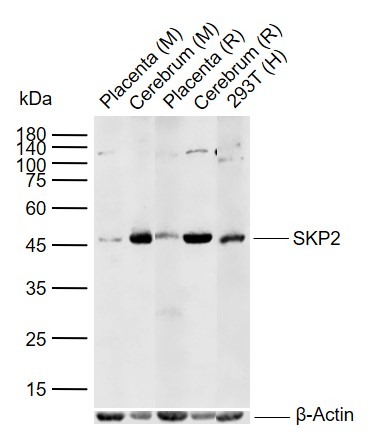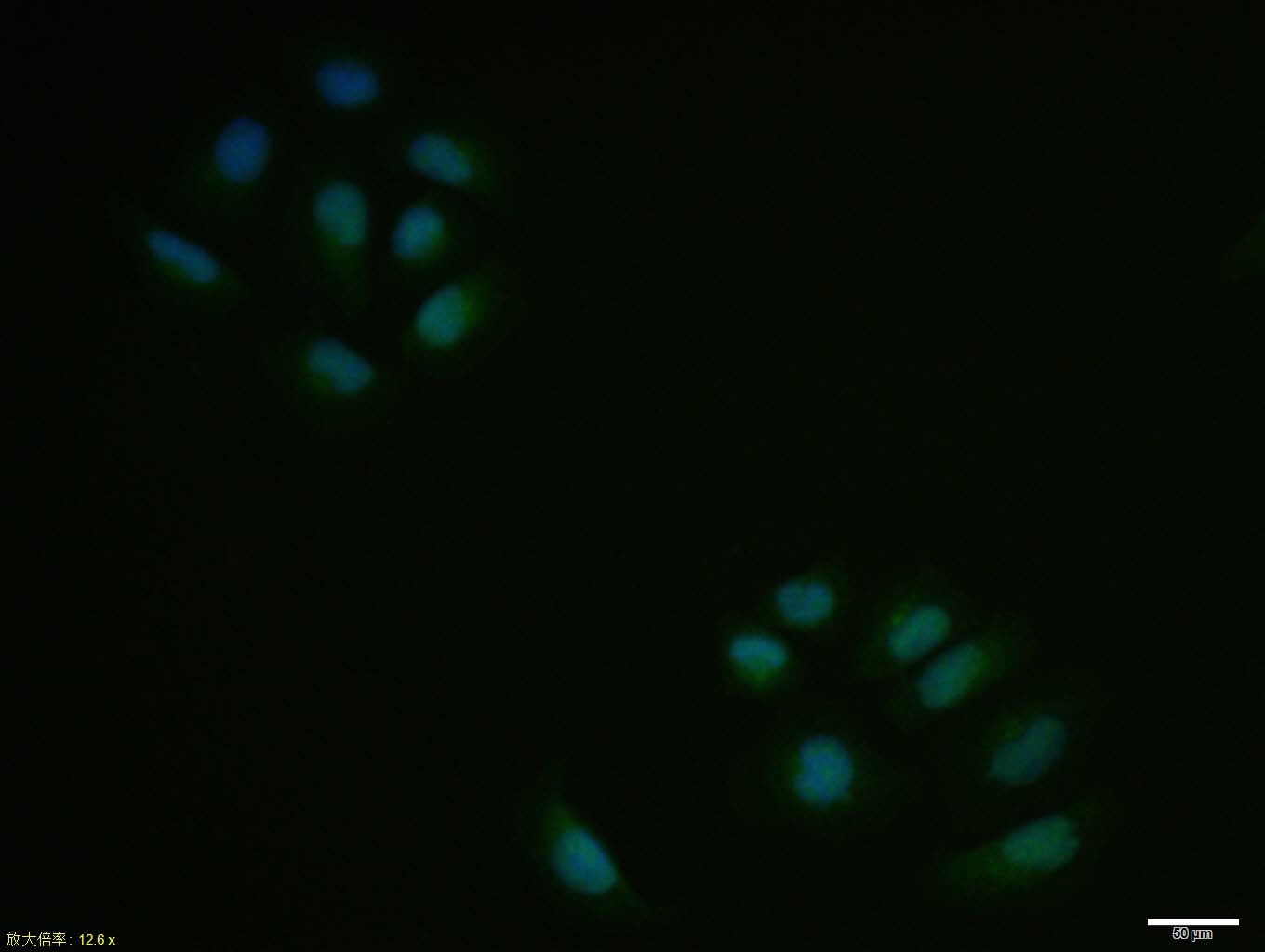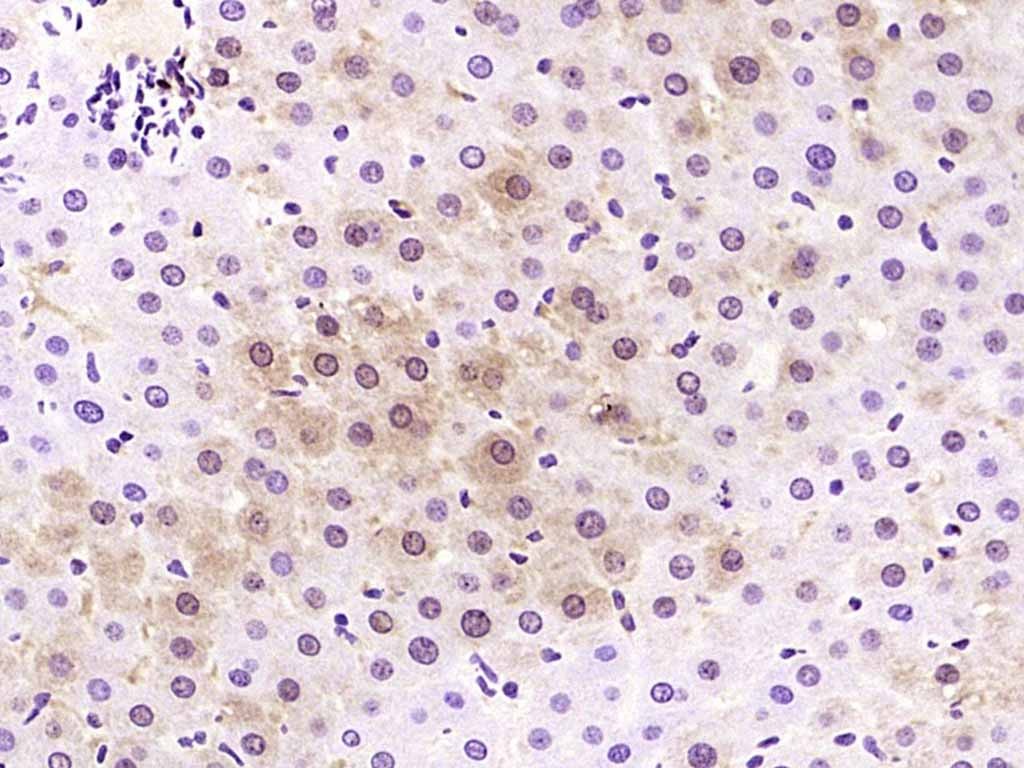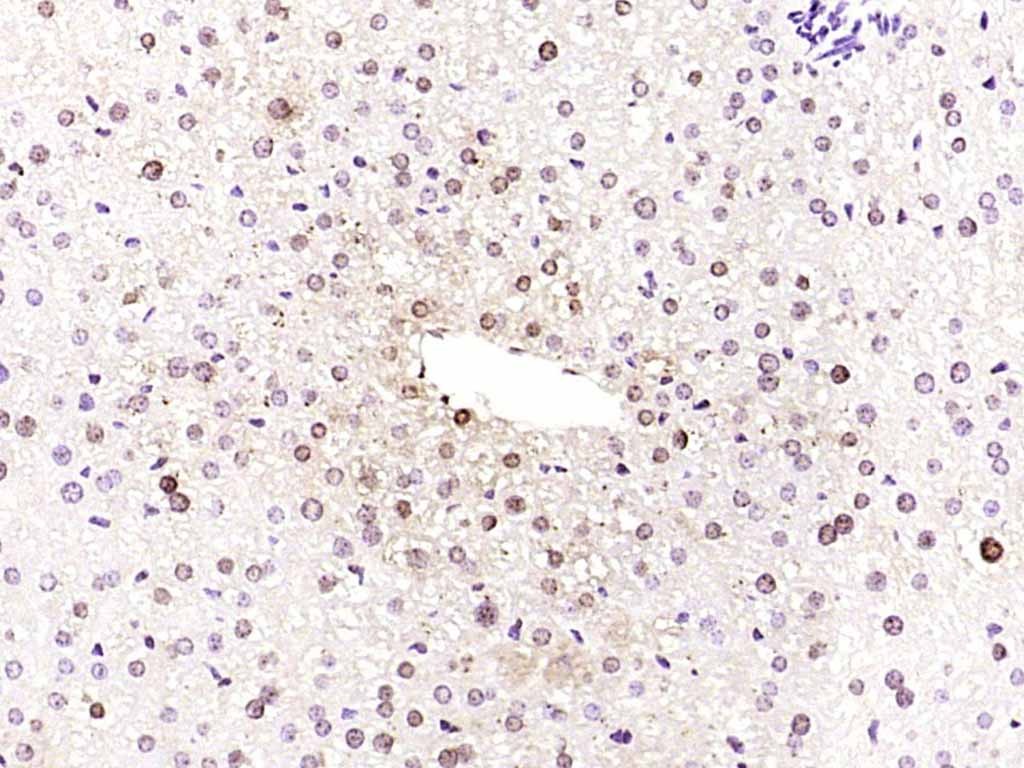Shopping Cart
Remove All Your shopping cart is currently empty
Your shopping cart is currently empty
Anti-SKP2 Polyclonal Antibody is a Rabbit antibody targeting SKP2. Anti-SKP2 Polyclonal Antibody can be used in ICC/IF, IF, IHC-Fr, IHC-P, WB.
| Pack Size | Price | USA Warehouse | Global Warehouse | Quantity |
|---|---|---|---|---|
| 50 μL | $221 | 7-10 days | 7-10 days | |
| 100 μL | $372 | 7-10 days | 7-10 days | |
| 200 μL | $527 | 7-10 days | 7-10 days |
| Description | Anti-SKP2 Polyclonal Antibody is a Rabbit antibody targeting SKP2. Anti-SKP2 Polyclonal Antibody can be used in ICC/IF, IF, IHC-Fr, IHC-P, WB. |
| Ig Type | IgG |
| Reactivity | Human,Mouse,Rat (predicted:Cow,Rabbit) |
| Verified Activity | 1. Sample: Lane 1: Mouse Placenta tissue lysates Lane 2: Mouse Cerebrum tissue lysates Lane 3: Rat Placenta tissue lysates Lane 4: Rat Cerebrum tissue lysates Lane 5: Human 293T cell lysates Primary: Anti-SKP2 (TMAB-01697) at 1/1000 dilution Secondary: IRDye800CW Goat Anti-Rabbit IgG at 1/20000 dilution Predicted band size: 48 kDa Observed band size: 46 kDa 2. Hela cell; 4% Paraformaldehyde-fixed; Triton X-100 at room temperature for 20 min; Blocking buffer (normal goat serum) at 37°C for 20 min; Antibody incubation with (SKP2) polyclonal Antibody, Unconjugated (TMAB-01697) 1:100, 90 minutes at 37°C; followed by a conjugated Goat Anti-Rabbit IgG antibody at 37°C for 90 minutes, DAPI (blue) was used to stain the cell nucleus. 3. Paraformaldehyde-fixed, paraffin embedded (rat liver); Antigen retrieval by boiling in sodium citrate buffer (pH6.0) for 15 min; Block endogenous peroxidase by 3% hydrogen peroxide for 20 min; Blocking buffer (normal goat serum) at 37°C for 30 min; Antibody incubation with (SKP2) Polyclonal Antibody, Unconjugated (TMAB-01697) at 1:200 overnight at 4°C, followed by operating according to SP Kit (Rabbit) instructionsand DAB staining. 4. Paraformaldehyde-fixed, paraffin embedded (mouse liver); Antigen retrieval by boiling in sodium citrate buffer (pH6.0) for 15 min; Block endogenous peroxidase by 3% hydrogen peroxide for 20 min; Blocking buffer (normal goat serum) at 37°C for 30 min; Antibody incubation with (SKP2) Polyclonal Antibody, Unconjugated (TMAB-01697) at 1:200 overnight at 4°C, followed by operating according to SP Kit (Rabbit) instructionsand DAB staining.     |
| Application | |
| Recommended Dose | ICC/IF=1:100-500; IF=1:100-500; IHC-Fr=1:100-500; IHC-P=1:100-500; WB=1:500-2000 |
| Antibody Type | Polyclonal |
| Host Species | Rabbit |
| Subcellular Localization | Cytoplasm. Nucleus. |
| Construction | Polyclonal Antibody |
| Purification | Protein A purified |
| Appearance | Liquid |
| Formulation | 0.01M TBS (pH7.4) with 1% BSA, 0.02% Proclin300 and 50% Glycerol. |
| Concentration | 1 mg/mL |
| Research Background | Substrate recognition component of a SCF(SKP1-CUL1-F-box protein) E3 ubiquitin-protein ligase complex which mediates the ubiquitination and subsequent proteasomal degradation of target proteins involved in cell cycle progression, signal transduction and transcription. Specifically recognizes phosphorylated CDKN1B/p27kip and is involved in regulation of G1/S transition. Degradation of CDKN1B/p27kip also requires CKS1. Recognizes target proteins ORC1L, CDT1, RBL2, MLL, CDK9, RAG2, FOXO1A, UBP43, and probably MYC, TOB1 and TAL1. Degradation of TAL1 also requires STUB1. Recognizes CDKN1A in association with CCNE1 or CCNE2 and CDK2. [PATHWAY] Protein modification; protein ubiquitination. [SUBUNIT] Part of the SCF(SKP2) complex consisting of CUL1, RBX1, SKP1 and SKP2. Interacts directly with CUL1 and SKP1. Interacts with CKS1. Interacts with the cyclin A-CDK2 complex. Interacts with ORC1L, phosphorylated CDT1, phosphorylated RBL2, ELF4, phosphorylated RAG2, FOXO1A, UBP43, MYC, TOB1, TAL1 and MLL. [SIMILARITY] Contains 1 F-box domain. [SIMILARITY] Contains 8 LRR (leucine-rich) repeats. |
| Immunogen | KLH conjugated synthetic peptide: human Skp2 |
| Antigen Species | Human |
| Gene Name | SKP2 |
| Gene ID | |
| Protein Name | S-phase kinase-associated protein 2 |
| Uniprot ID | |
| Biology Area | Oncoproteins,Transcription factors/regulators,F Box E3 Ligase |
| Function | Substrate recognition component of a SCF (SKP1-CUL1-F-box protein) E3 ubiquitin-protein ligase complex which mediates the ubiquitination and subsequent proteasomal degradation of target proteins involved in cell cycle progression, signal transduction and transcription. Specifically recognizes phosphorylated CDKN1B/p27kip and is involved in regulation of G1/S transition. Degradation of CDKN1B/p27kip also requires CKS1. Recognizes target proteins ORC1, CDT1, RBL2, MLL, CDK9, RAG2, FOXO1, UBP43, and probably MYC, TOB1 and TAL1. Degradation of TAL1 also requires STUB1. Recognizes CDKN1A in association with CCNE1 or CCNE2 and CDK2. Promotes ubiquitination and destruction of CDH1 in a CK1-Dependent Manner, thereby regulating cell migration. |
| Molecular Weight | Theoretical: 48 kDa. |
| Stability & Storage | Store at -20°C or -80°C for 12 months. Avoid repeated freeze-thaw cycles. |
| Transport | Shipping with blue ice. |
| Size | Quantity | Unit Price | Amount | Operation |
|---|

Copyright © 2015-2026 TargetMol Chemicals Inc. All Rights Reserved.